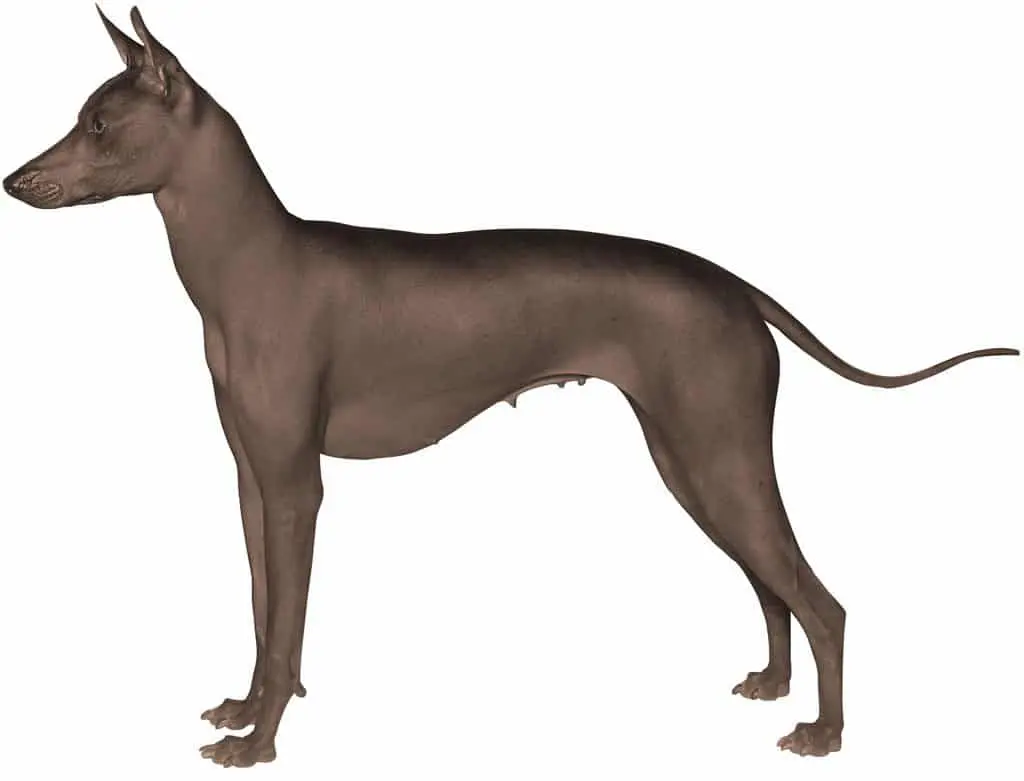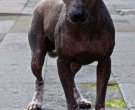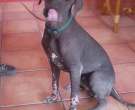Content |
|---|
History
One Xoloitzcuintle Mexican may be an unusual phenomenon, but it is by no means an eccentric invention of modern times. On the other hand, this breed of dog is probably many thousands of years old.
American dog researchers believe that the Xoloitzcuintle came to the west coast of Mexico on Chinese merchant ships. Others believe that it was introduced into Central America by Cortez and its occupying forces.
But, dogs that resembled the dog we know today existed in Mexico long before the arrival of the Spanish conquistadors – this is documented by archaeological finds. Scientists date a statue of about 1700 years before Christ. This proves that the Xoloitzcuintle Mexican is probably the oldest breed of dog in the American continent – and one of the oldest dog breeds in the world. Its exact origin is still unknown today., but it must be more than 4000 years. The fact that this dog can be seen in such art objects indicates that it was already considered valuable in pre-Christian times. Its name indicates that it was considered as the dog of the god Status, the aztec god of death.
“Xoloitzcuintle”: historical value
Today the breed of dog is supposed to have found many uses.: It was considered to be the companion of the souls of the deceased and therefore often had to give its life as a sacrificial animal or accompany its deceased owner to the grave.. At the same time, However, he was also a guardian of the house and farm and served as a hot water bottle due to his bare skin and high body temperature. The Mexican natives held the meat of the Xoloitzcuintle. One Xoloitzcuintle Naked was considered a delicacy and a diet enrichment.
Today it is kept as a companion and family dog and is considered intelligent., loving, sporty and calm. By nature you are sensitive and temperamental and want to be encouraged and kept busy. In very low temperatures and on hot sunny days, the owners of the Xoloitzcuintle they should protect their four-legged friend with a dog coat against hypothermia or with a special sunscreen against sunburn.
Physical characteristics “Xoloitzcuintle”
Height to the cross: 33 to 57 cm for dogs and bitches.
Weight: Weight depends on height.
The color:
The Xoloitzcuintle not furry, but it has a thick pile mop that goes from black to black-gray, Slate gray, dark grey, reddish, liver, bronze to golden yellow; sometimes stained. The skin is wrinkled on the head and neck and is grayish red. At birth, puppies are pink like piggies and don't look standard until they are one year old.
Typical and at the same time particularly striking are the bat ears of approx. 10 cm long, as well as almond eyes, which can be black to yellow.
Average life expectancy: 14 years
Character and skills “Xoloitzcuintle”
The Xoloitzcuintle is a quiet dog, affectionate, loving, sensitive and happy. He clings a lot to his family and wants to follow you everywhere. He seems to follow your voice and is a warm companion, gentle and affectionate. For this reason it is often used as a therapy dog.. He is also an energetic and agile athlete who loves to play and needs a lot of exercise and attention..
He loves his toys and likes to play in the yard or garden, warm up in the sun and need your long daily walks. When i'm outdoors, should always be kept on a leash, since he likes to hunt small animals. It is not a dog that wants to be left alone in the yard. Can jump or climb over fences. Must participate in family activities and depends on your affections and interests.
Although he is tender and affectionate with his family, is quite reserved and distrustful of strangers and needs a little time to get used to you. It learns fairly quickly and is easy to train, although sometimes it can be quite independent. You have to train it with a lot of determination and discipline.
You are protective by nature and have a strong drive to protect your home and loved ones. The Xoloitzcuintle is usually a quiet dog that only barks when there is a good reason for it. He's also fearless and won't shy away from a fight. Can get along well with other dogs and pets, if you have lived with other animals from a young age. He also gets along very well with children if they treat him with respect.
He is an exceptionally robust and healthy dog who needs a sweater in the cold and extremely hot seasons to protect his bare home.. It is an odorless dog that does not lose its hair.
Care “Xoloitzcuintle”
The Xoloitzcuintle he is an unusual dog, why don't you pant, but sweats through your skin, like us. But your skin is sensitive to the sun, it even burns in the sun. That is why you should always have a sunscreen with a medium sun protection factor with you at sea., in the city, in the field and in the mountains. The advantage of this breed is that the Xoloitzcuintle cannot hide ticks or fleas under its fur.
Can be stored on a floor, but a house with a garden is more suitable. Oddly enough, to the Xoloitzcuintle loves to roll in the snow in winter and bathe in icy water. But before I'm ready, you should get used to it little by little. A warm coat is advisable for walks in winter. But, it should be a felt coat lined with cotton, because your naked and sensitive skin can react allergic to wool.
Nutrition “Xoloitzcuintle”
The Xoloitzcuintle needs a lot of water, especially in summer, as a lot of fluid evaporates through your skin. In extremely hot weather, water with a high mineral content should be given to avoid a lack of salt. It also, the Xoloitzcuintle you need a balanced diet with a high proportion of protein. Unfortunately, thickens quickly, so you should avoid fat and sugar. With less exercise, it is better to feed it with green beans and rice.
The breeding of the Xoloitzcuintle
Breeding this ancient dog breed is problematic. Animal welfare experts even recommend a ban on breeding. Hairlessness is inherited in a dominant way. A dog with mixed genetic makeup is naked, a hairless quadruped does not carry the gene for hairlessness. But, a Xoloitzcuintle homozygous and hairless is not viable and dies shortly after birth.
To ensure healthy offspring, a Xoloitzcuintle heterozygous and naked would have to mate with a furry representative. The offspring would be viable, but only half would have no hair. Since the furry variant is not recognized as a breed in many countries, the mating of two hairless animals is often practiced and the death of non-viable animals is accepted. This circumstance makes the breed controversial and appears again and again in the context of torture breeding.. It also, the hairlessness gene also increases the predisposition to jaw malformations and missing teeth, and Xoloitzcuintle Mexicans also have a stronger tendency to various skin diseases and immune deficiencies.
Health “Xoloitzcuintle”
In addition to concern about the difficulty of breeding, some health problems are particularly common in theXoloitzcuintle. The first and most important thing is dental defects, so dogs missing some or all of their teeth and/or jaw malformations are hereditary. It also, immunological deficiencies are frequently found and the breed is predisposed to skin diseases such as purulent inflammations. So, if you decide to choose this breed, it is important that you choose a breeder carefully and that you are willing to invest a lot of time and money in caring for your dog.
Images "Xoloitzcuintle"
Photos:
1 – A Xoloitzcuintle (Mexican Hairless Dog). by Micyaotl G.T., CC BY 2.0
2 – Xoloitzcuintli or Xoloitzcuintle by Alfredo&Sara aguirre, CC BY-SA 2.0, via Wikimedia Commons
3 – Hairless Dog, preHispanic. by Rod Waddington, CC BY-SA 2.0, via Wikimedia Commons
4 – Xoloitzcuintle by https://flic.kr/p/agfgec
5 – Xoloitzcuintle by https://pixabay.com/es/photos/imagen-perro-mascota-canino-2628918/
6 – Xoloitzcuintle or Mexican hairless dog in Mérida, Yucatán, Mexico by Dénes Emőke, CC BY-SA 4.0, via Wikimedia Commons
Videos "Xoloitzcuintle"
|
HTTPS://youtube.com/watch?v=O4xn3Zzryr4
“Xoloitzcuintle”, the breed with historical value
|
HTTPS://youtube.com/watch?v=0Vk5iKiOd8w
ALL ABOUT XOLOITZCUINTLI: THE MEXICAN HAIRLESS DOG
|
|---|
Type and recognitions:
- FCI CLASSIFICATION: 234
- Group 5: Spitz and primitive types
- Section 6: Primitive type. Without working trial..
Federations:
- – FCI – Group 5: Spitz-type dogs and primitive type – Section 6: Primitive type. ⓘ
FCI breed standard "Xoloitzcuintle"
Alternative names:
1. Mexican hairless dog, xolo (English).
2. xolo, chien nu mexicain, chien nu du Mexique (French).
3. Xoloitzcuintle, Tepeizeuintli, xolo (German).
4. Xoloitzcuintle, xolo (Portuguese).
5. Xolo, Perro azteca, Perro mexica. Perro con y sin pelo mexicano, Bogar, xoloitzcuintli (español).








you're all right. your data, Pet. lack of information, and they only misinform those who want to know about the xolo. very bad reporter.
Hello friends of pets. Excuse me for contradicting you, but to write an article like this, you should be better informed. The XOLOITZCUINTI has nothing to do with the Hopi culture or with this god you oppose and something else., I do not know the American Hairless Terrier but it is false that it is the only breed with a recessive gene since that is precisely why the XOLO lacks hair and some teeth, because it has a “dominant recessive gene” What gives it this characteristic? Please check the page of the Mexican Canophytic Federation, there is correct information about the breed so that people are not confused..
Hello Tigra78, mz well expressed with rayon z….
di,and porfa where I can get a Xolo no standard in Spain hairs here in Mexico because of no answer…
A greeting